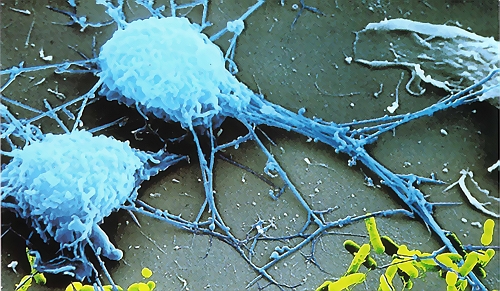 細胞培養進口血清進口胎牛血清進口新生牛血清進口豬血清馬血清
細胞培養進口血清進口胎牛血清進口新生牛血清進口豬血清馬血清 支原體檢測盒及標準品常規PCR檢測試劑盒熒光定量PCR檢測(qPCR法)支原體DNA提取靈敏度標準品(方法驗證用)特異性標準品(方法驗證用)PCR定量標準品(可用于方法驗證)
支原體檢測盒及標準品常規PCR檢測試劑盒熒光定量PCR檢測(qPCR法)支原體DNA提取靈敏度標準品(方法驗證用)特異性標準品(方法驗證用)PCR定量標準品(可用于方法驗證) 支原體祛除試劑細胞中支原體祛除環境支原體祛除水槽支原體祛除
支原體祛除試劑細胞中支原體祛除環境支原體祛除水槽支原體祛除 干細胞培養基
干細胞培養基 DNA/RNA污染祛除DNA/RNA污染祛除試劑DNA污染監測
DNA/RNA污染祛除DNA/RNA污染祛除試劑DNA污染監測 RNA病毒研究試劑RNA病毒檢測試劑盒病毒RNA提取
RNA病毒研究試劑RNA病毒檢測試劑盒病毒RNA提取 PCR儀器及配套產品DNA污染監測祛除PCR/qPCR儀性能檢查PCR試劑PCR試劑盒PCR預混液(凍干粉)熱啟動聚合酶MB Taq DNA
PCR儀器及配套產品DNA污染監測祛除PCR/qPCR儀性能檢查PCR試劑PCR試劑盒PCR預混液(凍干粉)熱啟動聚合酶MB Taq DNA 微生物PCR檢測食品檢測類產品食品微生物檢測細菌PCR檢測
微生物PCR檢測食品檢測類產品食品微生物檢測細菌PCR檢測
- 細胞培養進口血清進口胎牛血清進口新生牛血清進口豬血清馬血清
- 支原體檢測盒及標準品常規PCR檢測試劑盒熒光定量PCR檢測(qPCR法)支原體DNA提取靈敏度標準品(方法驗證用)特異性標準品(方法驗證用)PCR定量標準品(可用于方法驗證)
- 支原體祛除試劑細胞中支原體祛除環境支原體祛除水槽支原體祛除
- 干細胞培養基
- DNA/RNA污染祛除DNA/RNA污染祛除試劑DNA污染監測
- RNA病毒研究試劑RNA病毒檢測試劑盒病毒RNA提取
- PCR儀器及配套產品DNA污染監測祛除PCR/qPCR儀性能檢查PCR試劑PCR試劑盒PCR預混液(凍干粉)熱啟動聚合酶MB Taq DNA
- 微生物PCR檢測食品檢測類產品食品微生物檢測細菌PCR檢測
|
|
預防和清除支原體污染的細胞培養方法2016-10-09 12:47
 Since one of the main sources of mycoplasma is the cell cultures brought from outside, it is suggested to supply cells from reliable cell banks. In the case of the existence of mycoplasma contaminated cell culture in quarantine and the absence of separate incubators, only flasks in a plastic box with lid should be used. Never use plates and unsealed dishes in quarantine. In the case of suspected cultures, handling them at the end of the workday after all other cell culture work is completed, using separated media and reagents, and finally disinfecting the laminar flow hood after working is strongly suggested . Only use antibiotics responsibly Although ideally antibiotics used for cell culture should eradicate all contaminants, be nontoxic for the host cells and not interfere with experiments, none of the available antibiotics meet the mentioned criteria. Therefore, application of antibiotics in cell culture should be limited. Instead, a good aseptic practice plays an important role in prevention of contamination. Microbial contamination in cell culture which is antibiotic free is detectable by turbidity or color changes in cell culture medium. In the case of using antibiotics in a cell culture, there are four possibilities: 1. susceptibility to antibiotics, 2. resistance to antibiotics, 3. partial resistance to antibiotics, 4. resistance to antibiotics only by mycoplasma. The last one is the worst contamination since mycoplasmas can be spread by aerosols. In the case of antibiotic susceptibility, antibiotics prevent the cultivation of bacteria and fungi, but are incapable of precluding mycoplasma from the beginning. Therefore, continuous use of antibiotics for a long time in cell cultures not only is not helpful, but also can cause more problems. However, the use of antibiotics (Penicillin/ Streptomycin) for a short term (the first two weeks) in primary culture is vital. Since antibiotics are unstable in the medium, it is highly suggested to replace antibiotic containing medium with fresh medium every two or three days . Discard or treat mycoplasma contaminated cells In the case of mycoplasma contamination of cells which are really valuable and rare, it is suggested to treat them to eliminate mycoplasma infection. Otherwise, it is recommended to discard mycoplasma contaminated cells since they are considered as a source of contamination in the lab .
|
 細胞培養進口血清
細胞培養進口血清 支原體祛除試劑
支原體祛除試劑 干細胞培養基
干細胞培養基


